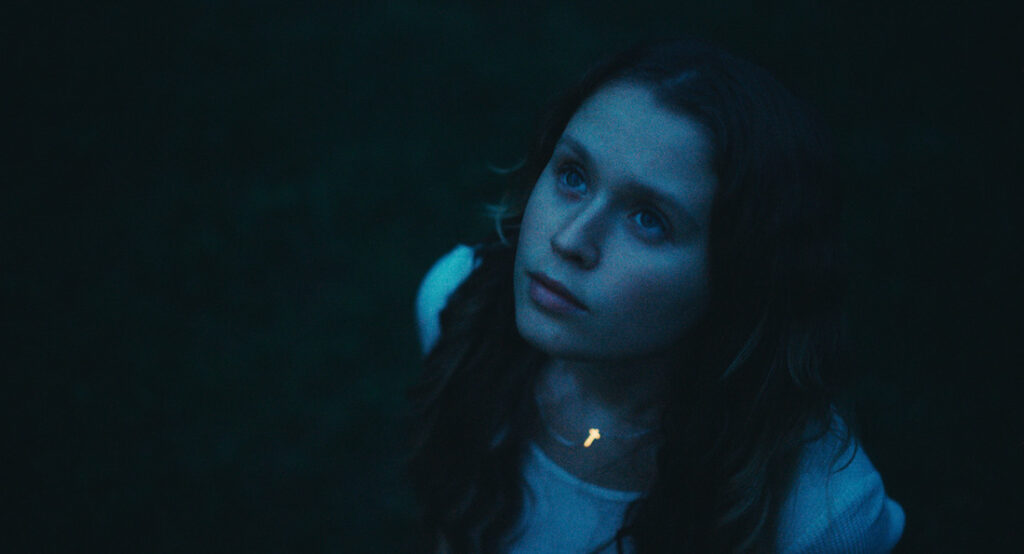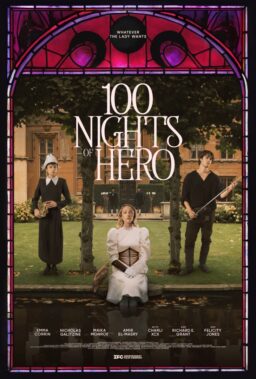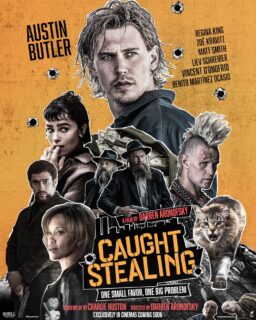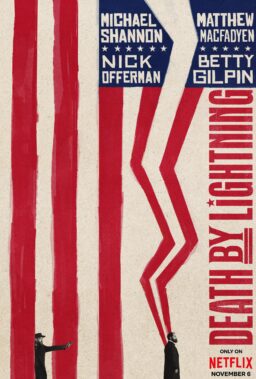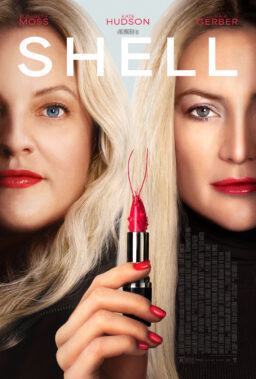An emotionally complex and sensitively told coming-of-age story, Laurel Parmet’s “The Starling Girl” explores questions of love, self-sacrifice, and agency within institutions of faith and family, even as it remains rooted in its protagonist’s gradually maturing perspective.
A showcase for star Eliza Scanlen, “The Starling Girl” casts the rising Australian actress—and “Sharp Objects” standout—as 17-year-old Jem Starling. Living in a fundamentalist Christian community in rural Kentucky, Jem is enamored of her church’s dance group but troubled by her parents’ suggestion that such a pursuit could lead her to sin, as well as by their desire to arrange her marriage to a church elder’s son (Austin Abrams).
Jem is thrown into further turbulence by her intense connection with youth pastor Owen (Lewis Pullman). As their bond deepens and soon turns transgressive, Jem struggles with conflicting loyalties to the church, her community, and her autonomy. Writer/director Parmet, whose empathetic lens previously distinguished shorts “Spring” and “Kira Burning,” steers her feature debut through a compassionate yet unflinching interrogation of power dynamics in religion and sexuality, the kind that can engender both desire and shame, repression and liberation.
“The Starling Girl” premiered at Sundance earlier this year, with Bleecker Street then acquiring the film for stateside release on May 12th. Out of the festival, RogerEbert.com sat down with Parmet, Scanlen, and Pullman to discuss filming some of its most challenging scenes, not losing sight of their main character, and dancing as a form of sacred self-expression.
This interview has been edited and condensed.

Let’s start by discussing the film’s origins. Laurel, I know you had spent time with women from a religious fundamentalist community while working on another project.
Laurel Parmet: That was eye-opening for me. My first instinct when I met them was to think, “Wow, this is really backwards.” Their church believed that patriarchy was ordained by God, that women were created to submit to men, and that it was the woman’s responsibility not to lead a man into temptation. These women basically learned to be ashamed of their desires, that their bodies are not their own, that their bodies belonged to God.
At first, I felt like it was pretty backward. But, the more I thought about it, I saw similarities to how I grew up, in our culture. When I was a teenager, I had a relationship with an older guy and had guilt about it, because I had a lot of agency. I pursued him. I didn’t feel like a victim. I felt like I was mature enough in what was happening. My time with those women was meaningful because it made me reflect back on my own relationship. It made me think about it in ways that I hadn’t before, and it made me recognize that guilt and think about it. It made me realize how universal the female experience is, no matter how you grow up.
To that end, Eliza and Lewis, which elements of “The Starling Girl” most resonated with you upon first reading the script?
Eliza Scanlen: When I’m reading a script, it’s less about one particular thing that I’m drawn to. It’s more about the feeling I get when I read it and the feeling I’m left with when I finish it. This script was incredibly moving to read, and every beat was so loaded. You could tell that Laurel had thought about every choice she made in the script. The challenge of playing Jem was in capturing the fiery spirit she has within the constrictions that she faced within this Christian fundamentalist community.
Lewis Pullman: The way Laurel wrote and aimed to go about shooting this was with ultimate human intentions. It felt strangely like we were re-enacting a documentary. We were trying to stray away from narrative expectations, which is exciting and rare. Laurel was our compass. Obviously, I had a very different upbringing and experience of my life, but what’s so great about how Laurel went about it, and how Eliza and all the other actors performed it, is that the film harnesses universal themes of expectations and shame. Even in Owen’s character, I was able to sympathize with the suppression, with the muzzle that he might feel like he has on his expression, and with how, when that’s tamped down, it can come out in ugly ways.
Laurel, your short film “Spring” addresses the complexity of the female gaze, and how desire and shame can complicate and charge it, in ways that people aren’t often conscious of at a young age. Can you discuss “The Starling Girl” in connection to that idea?
Parmet: It’s about the female gaze, and it’s about desire. All of my female characters are propelled by this deep desire and don’t think about the consequences. Maybe there’s something personal in there. [laughs] Obviously, “The Starling Girl” deals with empowerment and abuse. It walks this fine line, or at least I attempted to, because it’s tricky. I wanted to make sure that we never lost sight of Jem’s agency and her desires. She is a sexual being, and she has power at different points with Owen. She manipulates him to get what she wants. I wanted the audience to be able to experience the joy that she would experience at times. Even though it’s rocky and she feels extreme guilt, too, that desire should be there. That’s important. I wanted to make sure that Jem was strong, that she had agency, and, despite being taken advantage of at times, that she had power. In abusive relationships, you can still have power. We can be exploited while being empowered. Both things are true.

One scene in a car with Owen and Jem, where he takes her virginity, is especially deft in how it walks that tightrope, in how effectively it conveys the excitement, confusion, and hurt of Jem’s experience. You never lose sight of her. What discussions did you all have around filming that?
Parmet: This is going to sound weird, but that was one of my favorite sequences to film: the scene in the car and the scenes directly afterward. It’s when they’re in the car reckoning with what just happened, and afterward when she leaves and he follows her. That involved rehearsal and conversations with Lewis and Eliza. We were trying things out, making small adjustments here and there to make sure that we got that just right. We’re with her, and it’s exciting, and she’s in it, but then it goes too far, and it’s not what she wanted.
I want that moment in the car to be that point at which the audience can see, “Oh, this is messed up.” But then, not to simplify it, Owen’s like, “Hey, what’s wrong? I really like you.” In the car, what happens is you’re like, “This guy has gone too far. He is taking advantage of her.” And then he’s sweet to her again, but he puts it on her: “Why are you being so serious? Come on.” He’s trying to be playful with her and acting like she’s overreacting… And Owen’s not introspective at all. He’s not in a place where he can really reflect upon what just happened.
I’ve had that experience so many times in my life. And Eliza and Lewis were amazing at picking up on these little cues to get that just right. Every choice we made in terms of camerawork was about making sure we’re in Jem’s perspective, that we are experiencing what she’s experiencing and really feeling what she’s going through.
Pullman: We had a week of rehearsal before we started shooting, which is almost unheard of on an indie of this scale. Laurel was adamant about making sure that happened. Usually, you say that’s going to happen, and then things happen schedule-wise, and it always gets carved down to two days or even one day. We had a week of rehearsal, so we got to explore and build a common language among us three, a shorthand and a comfortable mode of conversing.
Normally, those kinds of scenes would be harder to articulate; you’re beating around the bush, or you’re trying to gauge what the other person is feeling and not speaking your mind as much. That we had this week, I felt, was integral to my feeling free to make a fool of myself, to try things that I thought had an 80% chance of failure and a 20% chance of being good. Normally, I keep those to myself.
Scanlen: The way the sex scene was written articulates their relationship so well, how their disparity in age makes their relationship complicated. Jem knows what desire feels like, but she’s never really acted upon her desires in such a drastic way. Having sex for the first time is such a huge moment in a young woman’s life, and it happens also quickly. Owen’s done this before, but at that moment, he’s so wrapped up in his own guilt that he can’t connect with Jem.
The way it was edited communicates that, the way that Owen pulls away at the end and leaves Jem lying there. He completely ignores the fact that he knows that it was her first time. To me, it’s such a powerful scene, and it was very important to get it right. What made that scene so unsettling was that it’s the first time they pass the point of no return. We had lots of conversations about how to nail those beats because there was a lot to communicate.

That this relationship plays out in a fundamentalist Christian community adds to its transgressive nature but also clarifies Jem’s sense of agency. The authority figures in this community all enact control over Jem’s body, whether restricting her movements in dance or telling her she must court Owen’s younger brother. What did you seek to capture about this community and Jem’s connection to it?
Parmet: I didn’t want to lean into the oppression visually. You do understand that this is an oppressive community, and you get that. What I wanted to do, visually, was ground the film in Jem’s perspective so that the audience experiences what she experiences. Sometimes, that is joy; sometimes, that is levity and beauty. Beautiful things can come from tight-knit communities and from faith. We wanted to show that side of the community as well. That was a part of every decision that we made, from the locations that we selected to the cast, the costumes, how we edited it, and the music we selected. We wanted to make sure that this community felt grounded and human.
Scanlen: Guilt felt like a vehicle for Jem’s actions and like a barometer for how she conducted herself. No one likes the feeling of guilt, but she let it rule her life. For me, it was important for the performance to feel relatively subdued. It’s quite a naturalistic film. I wanted to keep my performance subdued for the most part so that, when we had scenes like her showing her dance to her dance troupe or her performing at the church at the beginning of the film, we could have those pockets where Jem could express herself more largely than she usually does. And the references Laurel gave us did indicate to me how she saw the film existing tonally.
Could you elaborate on what those references were?
Scanlen: There was a documentary, “Stop the Pounding Heart,” that was hugely effective for me to understand the film, to exist in that community’s world, and not feel any judgment toward it.
Parmet: “Stop the Pounding Heart” is a beautiful doc-narrative hybrid about a fundamentalist family living in Texas, specifically following this one young woman as she’s starting to have some questions about faith. It’s a lovely, vérité portrayal. You’re just with this family, and the girl’s parents are so loving. God is such a comfort for them. They invite you into their world, and you see how their faith comforts them. I actually had all of our actors watch it.
Many films, documentaries, and books about conservative Christian faith can be so judgmental. “Jesus Camp” is a great and insightful film, but I told Eliza not to watch it. I didn’t want the actors to come into this with a closed mind. I wanted them to come into these characters with an open mind and be able to see the similarities between them and these characters. And “Stop the Pounding Heart” is a great visual reference for our film as well, so beautiful and lush.
I have to ask about the evolution of Jem’s dancing across “The Starling Girl.” It’s such an intimate part of this character, and I was moved by the way Jem gradually opens herself up through those performances.
Parmet: Firstly, I just love dancing in movies. If I could put a dance scene in every movie, I would. And maybe I will! When I first heard about worship dancing. I thought, “I have to put that in the movie. That’s so great.” Because it’s such a cinematic and visual way to convey the conflict that Jem is experiencing between the individual and the community. Jem feels most herself when she’s dancing, and she also feels most connected to God when she’s dancing. And she worries that, because she enjoys dancing, it means she’s somehow not honoring God.
That’s the struggle she experiences. And that’s also a struggle her father experiences with his music and with his faith. Over the course of the film, I wanted Jem to be able to see that she could have both, that she could hold onto this thing that she loves and be connected to God at the same time. It doesn’t have to be one or the other. I’m always going to choose a visual way to express things over doing so through dialogue if I can. And Eliza’s a great dancer.
Scanlen: Well, first of all, I’m not a good dancer. What are you guys talking about? [laughs]
Pullman: Yes, you are! The conviction you had within your performance, not just your moves but how you were truly experiencing it, was part of what made it so enrapturing.
Scanlen: Oh, stop it. I tried hard.
Parmet: Eliza was such a trouper. We had an amazing local choreographer who choreographed these two dances: the stiff, worshipful dance and the one that Jem choreographs, which is more free and more in tune with her physicality. Eliza had two hours over two weekends to learn each dance. She f–ing nailed it.
Scanlen: Two hours of rehearsal, but I was in my apartment practicing at 11 p.m., to myself, which is quite depressing. It paid off, I guess.

Did it connect you more deeply to the character, going out of your comfort zone and into hers in that way?
Scanlen: I think so. Dialogue is fun, but it’s easy for an actor to lean on the dialogue. In scenes like that, which require a bit more work, you can’t really rely on what might come up on the day. Whether it’s horse-riding or sword-fighting, you have to rehearse it well. I do like dancing, and it’s fun, and I can understand how that euphoric feeling for Jem was her way of connecting to God. That was a beautiful way for me to better understand Jem as a human being. She felt very real to me.
Parmet: I should also say one of my favorite things that we shot was when Jem is dancing in her backyard in the last light of day, and the sky is very blue. I think we had 20 minutes to shoot it; we just ran out there with a camera and filmed Eliza moving against the sky. Her cross caught this porch light, and it reflected with this burning orange glow on her chest in the shape of a cross as she’s dancing and looking up at the sky. It was one of the most incredible moments of the shoot, and those are my favorite parts of making films: those wonderful moments of surprise that fit so well thematically.
“The Starling Girl” opens in theaters in New York and Los Angeles on May 12th before expanding to additional cities on May 19th.

